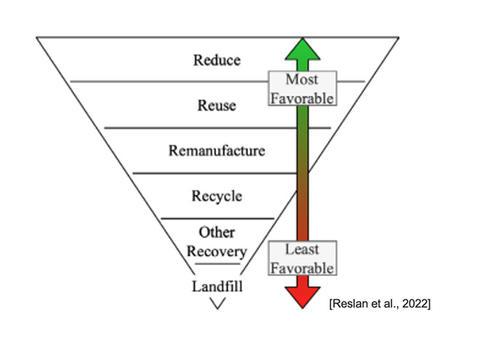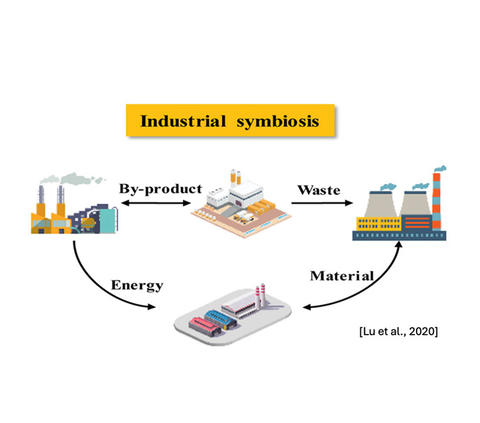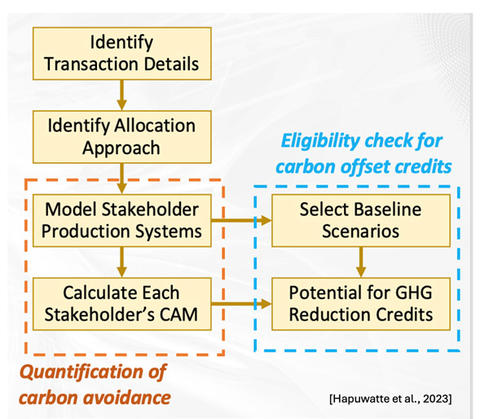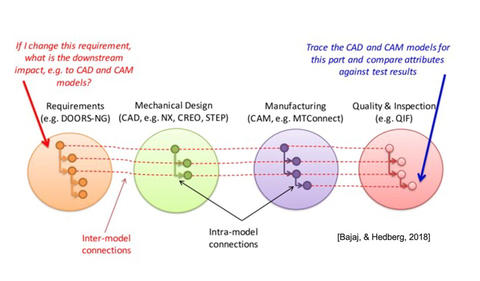Summary
High-demand consumable products made from plastics, or those such as consumer electronics like mobile phones, laptops, etc., are particularly problematic and are representative of the sheer scale of the problem. Increasing manufacturing efficiencies combined with shorter product use lifetimes and greater accessibility to a growing global middle class means manufacturers must meet rising consumer demands. The quick turnaround time also translates to large masses of products reaching their End-of-Use (EoU) phase simultaneously and subsequently being disposed of indiscriminately owing to a lack of well-established disposal/recovery infrastructure and little or no EoU guidelines. This, in turn, has accelerated society’s reliance on virgin natural resources and environmental degradation associated with mining, extraction, and processing of raw materials.
The Closed Loop Recovery Project is carrying out fundamental research rooted in Industrial Ecology, Complex Systems Science, and Operations Research methods. Through the development of integrated predictive modeling techniques, the four research thrusts will be used to examine and define critical material and information pathways that are vital to the development of reliable sources of secondary industrial feedstocks. Subsequently, the net environmental and economic impacts, along with potential supply chain risks, will also be examined. The research carried out will also be instrumental in identifying standards requirements, and methods, frameworks, metrics, and indicators developed will be used to facilitate CE standards development in ISO Technical Committee 323 on Circular Economy and the ASTM E60 Committee on Sustainability.
Description
Objective
To define critical material and information pathways to support the development of closed-loop systems to establish reliable sources of secondary material feedstocks that divert critical resources away from landfills using material recovery strategies - recycling, remanufacturing, and reuse. The project will develop tools and metrics that will enable circular economy standards that support sustainable development strategies.
Technical Idea
In the past, little consideration was placed on developing secondary material infrastructure and designing products for EoU material recovery [Mathur et al., 2023a]. Closing material loops is challenging in the context of multi-component, multi-material, such as consumer electronics products, in a global supply chain for several reasons, including a lack of information (collection, sorting, contamination, safety, etc.) and a lack of guidelines for post-processing. On the other hand, the growing plastic contamination issues can be attributed to its durability and variability in material compositions. According to the WEF, it is estimated that the recycling rate for WEEE is 32% in the US, while globally, it is less than 20% as of 2021. Worse still, the overall recycling rate for plastics in the US is only at about 4%, while globally, it is estimated to be 9%. [OECD, 2022]
The recovery of many end-of-use consumer products is impeded not just by technological and infrastructural barriers but also by the lack of information, which has resulted in EoU products simply being shredded and/or landfilled (when collected). This results in the loss of valuable resources besides environmental degradation and contamination (air, water, and soil) [Mathur et al., 2020]. In fact, the NIST-ASTM Workshop (April 2022) on Fostering a Manufacturing Circular Economy helped identify several factors that contributed to poor recovery and low demand for secondary feedstock materials. Most participants cited quality and contamination concerns that would interfere with product durability coupled with a lack of standardized ways of evaluating recovered materials. Furthermore, several participants also agreed that material traceability and more guidelines on how discarded products and materials need to be treated were essential to encourage proper collection and EoU treatment practices. It is clear that society needs to work towards identifying sectors that have the potential of devolving into the next plastics-waste crisis or e-waste crisis and implement preventative measures as opposed to attempting remedial measures once a product is already in use and in circulation in a highly global and interconnected market.
The Closed Loop Recovery Project has identified and aims to address two measurement science research gaps that will determine factors that will enable a ‘pull’ for secondary feedstocks:
- The lack of technical standards associated with EoU products.
- The lack of systems-level technical standards that will facilitate closing material and information loops via stakeholder cooperation, and thereby enable a CE.
Specifically, the current foci are CE for clean energy technologies and plastics [Mathur et al., 2023b; Chatterjee et al., 2024a]. Both these application areas are critical to the administration's 2050 net zero goals and economy-wide decarbonization efforts. Moreover, we will be exploring new research avenues in the context of critical materials, their role in transitioning to a clean energy economy, and understanding what this means for US OEMs and SMEs in terms of expansion opportunities and supply chain risks (CHIPS, complements DoE) [Mathur et al., 2024]. In addition, we will also be exploring the role of Carbon markets and digital threads in the context of promoting new business models and efficient information exchange, respectively, in order to promote a CE [Hapuwatte et al., 2023a]. Research and the resulting publications over the past year have helped make contributions to the ISO TC 323 WGs 1 & 3. Going forward, the intention is to ramp up engagement (in terms of technical contributions and leadership) at ISO TC 323 as well as with ASTM E60.13.
Research Plan
The implementation of CE requires careful systems-wide considerations that endeavor to balance multiple objectives and trade-offs concomitantly. In the case of manufacturing, product development, and the associated supply chains are influenced by several exogenous and endogenous factors. The interactions between these parameters are characterized by nonlinearities and other complexities. Consequently, product manufacturing within a CE framework gives rise to numerous complex systems and sub-systems that are constantly evolving and are characterized by numerous materials as well as informational feedback loops that make material recovery challenging. Two foundational research thrusts will be explored and subsequently also in unison with one another for both the identified cases. The first is the notion of the resource management hierarchy in the context of multi-material and multi-component products. In addition to the resource management hierarchy and the industrial symbiosis thrusts, the project will also explore two more research areas - the carbon accounting market and the digital thread in relation to information exchanges to facilitate closed-loop mechanisms.
| Thrust 1: Resource Management Hierarchy |
| Thrust 2: Industrial Symbiosis |
| Thrust 3: Carbon Market |
| Thrust 4: Digital Thread |
The resource management hierarchy (RMH) aims to enable decision-making by prioritizing EoU product recovery and treatment. In implementing a CE, emphasis needs to be placed on product and material reuse as much as possible, followed by remanufacturing, followed by recycling, and, if necessary, incineration and/or landfilling. The resource management hierarchy aims to preserve resources by balancing the economic, environmental, and social dimensions of sustainability. The second is industrial symbiosis, the notion by which “waste” and byproducts are utilized through the development of strategic synergies between diverse industries. Industrial symbiosis can be used to realize a CE through the exchange of resources, byproducts and even knowledge/data between diverse industries. Industrial symbiosis promotes open-loop recovery, i.e., discarded materials and byproducts are used to manufacture an altogether different product. Thus, industrial symbiosis relies on strong collaborations between firms and provides a less restrictive recovery framework than closed-loop recycling to implement CE approaches such as the resource management hierarchy. Building upon research, we also intend to explore the currently nascent C market. Standardizing methodologies to allocate C credits in a product value chain can help businesses align themselves with sustainability practices and CE [Hapuwatte et al., 2023].
The work proposed through this project will be beneficial to multiple stakeholders. These include manufacturers - Original Equipment Manufacturers (OEMs) and Small and Medium Enterprises (SMEs) - dismantlers and recyclers, standards-making bodies, and researchers. In line with CE, the work proposed in this project will help firms anticipate and implement strategies to circularize their products. Given the administration’s push towards decarbonization and the 2050 net zero aspirations, there lies a tremendous opportunity for building a robust infrastructure (via technological interventions as well as by developing standards and best practices) around clean energy tech to mitigate the reliance on the manufacturing sector on fossil fuels. Because many clean energy technologies and other novel technologies rely on high-value, critical minerals, the opportunity to strengthen supply chains via a CE is vital. Additionally, preempting and anticipating infrastructural requirements to circularize these sectors will potentially prevent another e-waste crisis.
Highlights
- Chatterjee A., Minsk, O., Hapuwatte, B. M., Triebe, M. J., Kietzer, D., Kittali-Weidner, S., Morris, K.C., & Mathur, N. (2024). Development Strategies for Industrial Byproduct Exchange Projects: Insights from Network Analysis – in review
- Mathur, N., Maani, T., Rong, C., & Sutherland, J. W. (2024) Forecasting Rare Earth Element Demands for Clean Energy Technologies with the Bass Diffusion Model, Procedia CIRP LCE – accepted
- Chatterjee, A., Mathur, N., Figola, D., Triebe, M. J., Hapuwatte, B., Hartwell, A., & Morris, K.C. (2024) Quantifying High Density Polyethylene Flows in the United States using Material Flow Analysis, MSEC – accepted
- Kim, Y., Deng, S., Maani, T., Mathur, N., Triebe, M. J., & Sutherland, J. W. (2024) Developing manufacturing-relevant indicators for assessing circularity of a product’s life cycle in the long-run behavior, SME NAMRC – accepted
- Hapuwatte, B. M., Mathur, N., Morris, K.C. (2023) Emissions avoidance quantification and allocation framework for secondary materials marketplaces supporting the circular economy. Proceedings of the ASME 2023 18th International Manufacturing Science and Engineering Conference (MSEC) 2023.
References
Chatterjee, A., Mathur, N., Figola, D., Triebe, M. J., Hapuwatte, B., Hartwell, A., & Morris, K.C. (2024) Quantifying High Density Polyethylene Flows in the United States using Material Flow Analysis, MSEC – accepted
Hapuwatte, B. M., Mathur, N., & Morris, K. C. (2023, June). Emissions avoidance quantification and allocation framework for secondary materials marketplaces supporting the circular economy. In International Manufacturing Science and Engineering Conference (Vol. 87233, p. V001T04A004). American Society of Mechanical Engineers.
Mathur, N., Last, N., & Morris, K. C. (2023a). A process model representation of the end-of-life phase of a product in a circular economy to identify standards needs. Frontiers in Manufacturing Technology, 3, 988073.
Mathur, N., Hapuwatte, B., & Morris, K. C. (2023b). A proposed integrated model to assess product recovery pathways: The case of solar photovoltaics. Procedia CIRP, 116, 83-88.
Mathur, N., Maani, T., Rong, C., & Sutherland, J. W. (2024) Forecasting Rare Earth Element Demands for Clean Energy Technologies with the Bass Diffusion Model, Procedia CIRP LCE – accepted
Mathur, N., Singh, S., & Sutherland, J. W. (2020). Promoting a circular economy in the solar photovoltaic industry using life cycle symbiosis. Resources, Conservation and Recycling, 155(August 2019), 104649
OECD (2022), Global Plastics Outlook: Policy Scenarios to 2060, OECD Publishing, Paris, https://doi.org/10.1787/aa1edf33-en.





